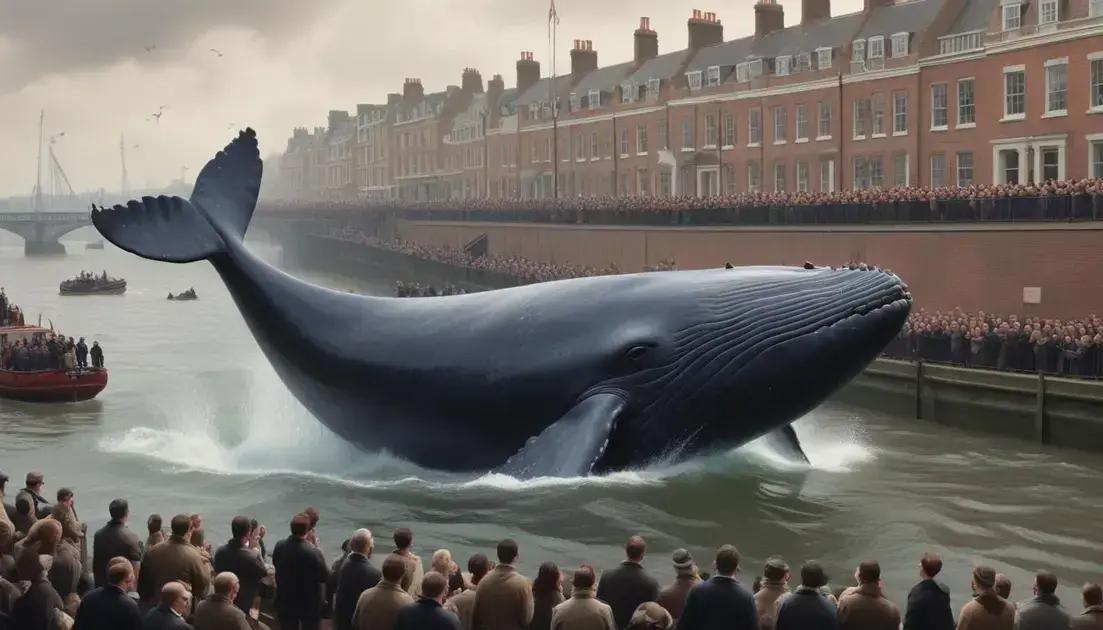
The Thames Whale: The Incredible Rescue Attempt in London
The Thames Whale incident in January 2006 sparked widespread public interest and raised awareness about marine conservation. A fin whale strayed into the River Thames, leading to massive rescue efforts that united local communities and highlighted the impact of human actions on wildlife. The event served as a reminder of the importance of protecting marine life from pollution and habitat loss, fostering discussions about sustainability and conservation practices among the public.
In January 2006, a shocking event unfolded in London as a Thames Whale was spotted in distress. This incident raised awareness about marine conservation.
Introduction to the Thames Whale incident
In January 2006, a curious event shocked Londoners. A Thames Whale swam into the River Thames. This whale was a fin whale, which is a type of baleen whale. It was about 5 meters long and quite lost. People gathered along the riverbanks to see this rare sight.
As news spread, more and more people arrived. The scene was both fascinating and worrying. Local authorities quickly moved into action. They knew they had to help the whale. A rescue operation was launched. Many organizations joined forces to save the animal.
Watching the whale struggle in the river was heartbreaking. Experts feared for its life. They worked with urgency to keep it calm and guide it back to the open sea. But time was running out. The attention this incident brought raised awareness about marine life. It sparked conversations about how human activities affect these creatures.
During this time, marine biologists and volunteers worked tirelessly. They used boats, nets, and even tranquilizers. Their goal was to save this beautiful animal. The situation was tense, but everyone hoped for a happy ending.
Details of the rescue efforts
The rescue efforts for the Thames Whale were intense and well-organized. As soon as news broke, teams of marine experts jumped into action. They understood that time was critical. The whale needed help right away.
Rescue teams used boats and equipment to approach the whale safely. They monitored its condition closely. Marine biologists joined the operation to provide guidance. Volunteers also played a key role. Many people wanted to help save this animal.
They used nets and special tools to try and steer the whale out of the river. At one point, they deployed a tranquilizer. This was meant to calm the whale and make the rescue smoother. However, all actions required careful planning.
A safety zone was set up around the area. This kept spectators at a distance. The goal was to minimize stress for the whale. The public watched anxiously, hoping for a successful outcome.
Despite the efforts, the situation was challenging. The river’s conditions made it tough for the teams. They had to work quickly and efficiently. Each moment counted in this life-or-death mission.
Public reaction and media coverage
The Thames Whale incident captured a lot of public interest. People flocked to the river to see the whale. News spread quickly through social media and TV. Many felt a mix of excitement and concern for the animal.
Local residents shared updates on social platforms. They posted photos and videos of the rescue efforts. Hashtags related to the whale began trending. This helped raise even more awareness.
News outlets sent reporters to cover the event. They provided live updates to keep the public informed. Many stories highlighted the animal’s plight and the dedication of the rescue teams. This coverage sparked conversations about marine conservation.
People began discussing how human actions impact wildlife. Many joined the call for better protection of marine life. The incident brought attention to issues like pollution and habitat loss. These topics became more relevant as the story unfolded.
Meanwhile, various organizations used this moment to educate the public. They shared information about marine ecosystems and conservation efforts. The Thames Whale incident transformed from a rescue attempt into a larger dialogue about protecting our oceans.
Impact on marine life awareness
The Thames Whale incident had a big impact on marine life awareness. Many people began to understand the challenges faced by whales and other sea creatures. This situation opened up important discussions about how humans affect marine ecosystems.
As news spread, more folks became curious about ocean health. They learned about pollution and its harmful effects. Plastic waste, for example, poses a severe threat to wildlife. The incident highlighted why keeping our waterways clean is vital.
Educators and environmental groups jumped in to share information. They used this moment to teach others about marine life and conservation efforts. Schools even organized field trips to discuss ocean science.
This increased awareness encouraged action. Many people started supporting local cleanups and conservation programs. They realized that small actions could lead to big changes for marine animals.
The focus on the Thames Whale sparked a movement for better protection of marine habitats. More people started contacting their local governments. They pushed for policies that support ocean conservation efforts. The incident showed how public interest can lead to real change.
Conclusion and reflections on human intervention
The Thames Whale incident makes us think about human intervention in nature. It shows our impact on marine life. When animals like whales stray into urban areas, it raises many important questions. Why did this happen? What can we do better?
Humans often influence wildlife. Pollution, noise, and habitat destruction can push animals away from their homes. The Thames Whale reminded us that we need to take responsibility. Our actions have consequences on the environment.
In this case, many people acted to help the whale. Their efforts showed how compassion can unite a community. However, we must focus on preventing similar situations from arising. This is not just about rescue; it’s also about protecting habitats.
We should consider how we can support marine conservation long-term. By reducing waste and protecting our oceans, we can help marine life thrive. Every small effort counts. Sharing knowledge and raising awareness is key to fostering a healthier environment.
Ultimately, the Thames Whale incident invites us to reflect on our relationship with nature. It challenges us to act wisely and protect our planet for future generations.
Conclusion
In conclusion, the Thames Whale incident underscores the importance of our role in protecting marine life. It highlights how human actions can affect wildlife and ecosystems. When we witness events like this, it’s a reminder of our responsibility to care for the environment.
The collective response to rescue the whale showed the power of community action. People from all walks of life came together with compassion and dedication. This effort sparked discussions about marine conservation and awareness of ocean health.
As we move forward, it’s vital to focus on sustainable practices. Reducing pollution and protecting natural habitats can help ensure the safety of marine creatures. Every little action can make a significant difference. Education and advocacy are key to fostering lasting change in our interactions with nature.
Ultimately, let’s use what we’ve learned from the Thames Whale to take better care of our oceans. By doing so, we create a healthier environment for all living beings and pave the way for future generations to appreciate the wonders of marine life.


